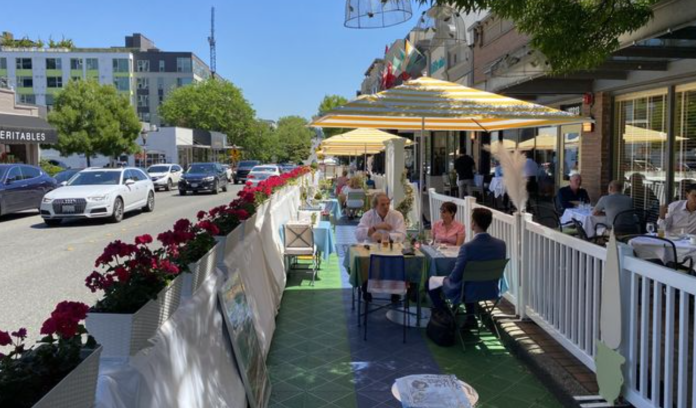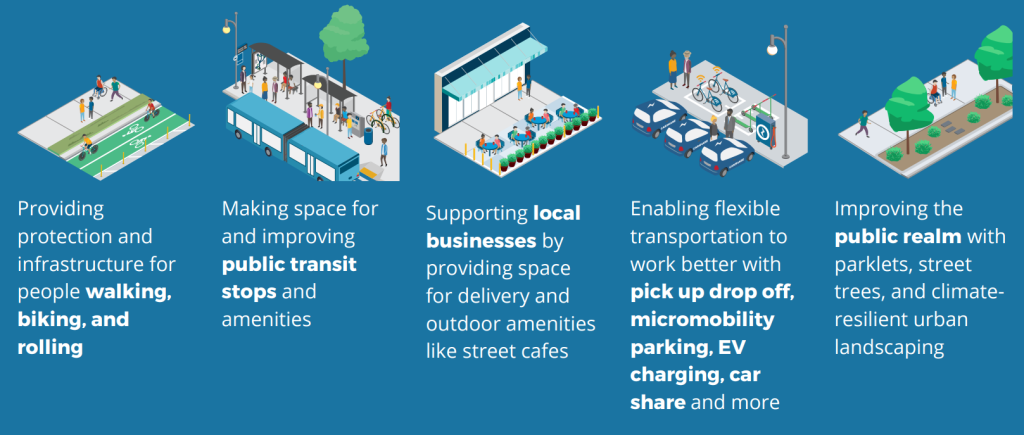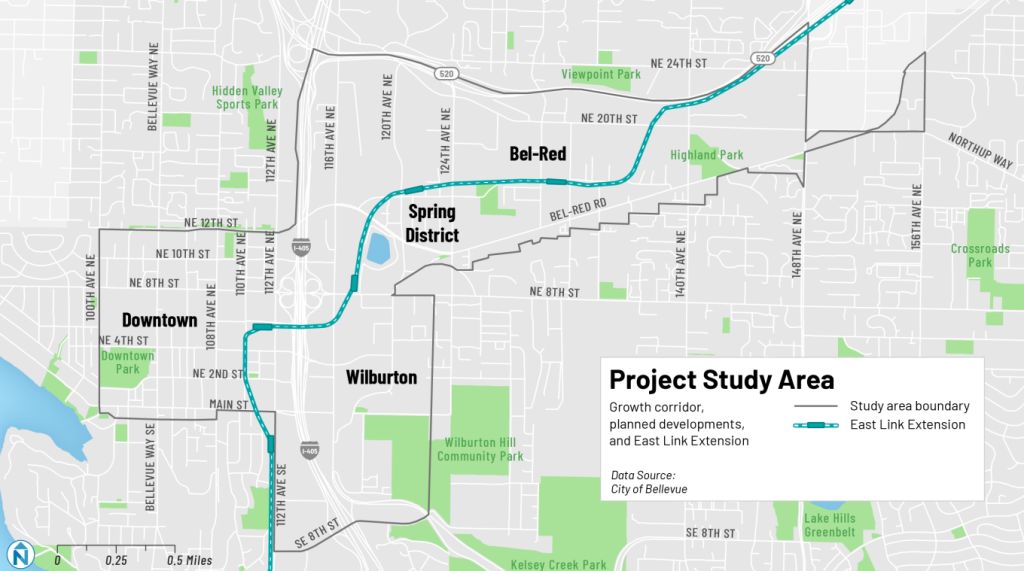
The City of Bellevue has created a roadmap for the potential broad expansion of curbside street space that shifts away from being focused primarily on single-occupancy vehicle movement and storage. The new Curb Management Plan was approved by the city’s transportation commission Thursday night and heads to the Bellevue City Council for approval.
In the works since early 2022, the plan has been molded and shaped over many months of outreach and years of work to provide city leaders a toolkit for how to move forward with rethinking how those valuable spaces function to achieve broader city goals, like improved safety, vibrancy, and increased transit ridership.
Currently, the vast majority of space along the curb in Bellevue’s downtown area is devoted to cars, as travel lanes or as parking. Just 3% of the space along curbs downtown is devoted to loading, bus stops, or transit-only lanes. Most of that street space is travel lanes, with nearly 60% of that street space trying to provide vehicle throughput — leading to Bellevue’s reputation as a very auto-oriented city. Having fast-moving traffic directly next to pedestrian traffic also provides no buffer, impacting the city’s safety goals.

The City of Bellevue is beginning to see those car-centric uses as unsustainable. While Bellevue has made progress on things like creating the foundation for a downtown bike network, making space for buses around Bellevue Transit Center, and approving street dining, most of those projects happened on an individual level. To make them scalable across the entire city, as Bellevue plans to add anywhere from 124,000 to 200,000 jobs and 40,000 to 90,000 housing units over the next two decades, the city needs a more formal foundation to look to, which is where the Curb Management Plan comes in.

“The onus of this project was to plan for growth,” said Christopher Iverson, Senior Transportation Engineer with the City of Bellevue, at city’s transportation commission earlier this month. “As the city grows, so will our practices along the curbside, as well as addressing those changing mobility and livability demands that we experience. Right now, our operations are case-by-case, a lot of decisions are made ad-hoc across different groups and departments at the city, there’s not immense transparency in terms of those decisions. The approach that we take with permitting and pricing is inconsistent and arguably inequitable, and our enforcement resources for the curb are very limited.”

With the adoption of the plan, Bellevue will be poised to implement a number of pilot programs intended to improve how limited curbspace is used. One of those would encourage people to store their vehicles in off-street parking stalls — Bellevue has over 55,000 stalls in downtown, Bel-Red, and the Spring District — rather than on the public street. Other pilots include studying the availability of on-street loading in specific areas, and testing curb zones specifically for low-emission delivery vehicles, like ebikes, locker hubs, and electric trucks. All of these will be happening against the backdrop of the continued expansion of the city’s bike network along growth corridors near coming light rail stations, a plan being called Bike Bellevue.

“This work really does seem to be with the goal of making Bellevue an actual city,” Christopher Randels, chair of Complete Streets Bellevue, told The Urbanist. (Randels has been a contributor to The Urbanist.) “I hope that this framework, by creating more spaces that are not devoted to automobile traffic… starts to change the culture of the city in a way that pedestrians, cyclists are more visible, they’re more seen as a part of the transportation ecosystem. That people who are driving are more aware of their surroundings because they’re in a vibrant place that’s full of people.”

Those changes will not come without conflicts between different types of street users vying for the same space. Bellevue transportation planning commissioner Loreana Marciante pushed the city to wade into those fights about tradeoffs, arguing that opportunities that come without impacts to other modes will be few-and-far-between in Bellevue.
“We need to start having really important tradeoff conversations,” she said earlier this month. “There are people with interests on all sides of modes… we are not in a position at this point to [be able to] make decisions that benefit one mode but don’t negatively impact another. We need to have the tools to communicate… what we’re seeing, and to have those conversations, openly, transparently, to say ‘yes, this is going to decrease this, and you might have to wait two minutes more at this light, but this is going to increase the level of safety, for someone’s life.'”
Pushback on the Curb Management Plan is mostly coming from groups raising concerns about losing space for vehicle throughput on Bellevue’s streets. Jodie Alberts, Vice President of Government Affairs for the Bellevue Chamber of Commerce, noting that she currently commutes to the city from Mill Creek, spoke positively of the plan otherwise.
“Ensuring that throughput is prioritized in some of these high-traffic areas is important for a person like me, but also for the business community in Bellevue, to ensure it continues to thrive,” Alberts told the transportation commission.
But the Chamber has come out in full support of the expansion of the city’s bike network, though it remains to be seen whether that support will remain steadfast when the city starts reallocating space on major corridors.
While the tough work comes after the plan is adopted, Bellevue’s coming adoption of the Curb Management Plan signals that Washington’s fifth largest city is trying to break free of the status quo that governs some of its most valuable street space, using that public real estate to achieve broader city goals. In a city as process-oriented as Bellevue, no other way forward likely exists.
Ryan Packer has been writing for The Urbanist since 2015, and currently reports full-time as Contributing Editor. Their beats are transportation, land use, public space, traffic safety, and obscure community meetings. Packer has also reported for other regional outlets including BikePortland, Seattle Met, and PubliCola. They live in the Capitol Hill neighborhood of Seattle.

